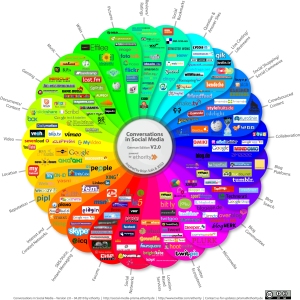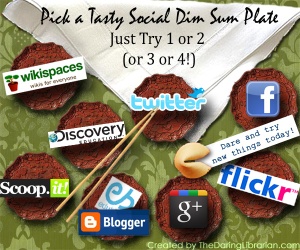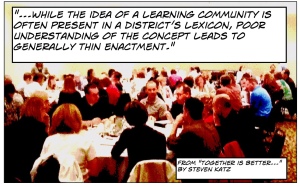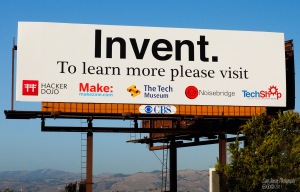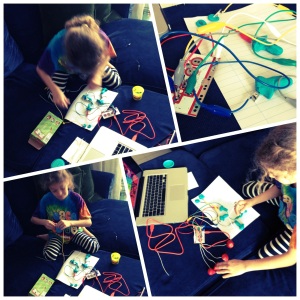This week Gee asked an interesting question of, “What if human minds are not meant to think for themselves by themselves, but, rather, to integrate with tools and other people’s minds to make a mind of minds?” in Anti-Education Era. (Gee, 2013, p.153) He talks about “affinity spaces” where any person with passion can contribute productively. (Gee, 2013, p. 173-177) I am not an expert yet in any of these spaces, but I’m working towards that. My PLC at work is a space (virtual and in-person) where I contribute ideas to the group to better our school procedures, policies, and lessons.
Thinking about my possible affinity spaces led to me thinking about my “information diet”, where I gather my news and ideas from others. Every morning when I’m waking up I go through a list of apps on my phone: Facebook, Instagram, Pinterest, Twitter, SnapChat, and Gmail. I read information from friends or sites usually with similar views than me. This is probably true of most people on the internet where we go to “ideologically driven sites where people echo each other’s views and values endlessly and mindlessly”. (Gee, 2013, p.163)
I was challenged this week to look for new sources of information that think differently than I do on educational issues. I decided to follow people on Twitter that I normally wouldn’t:
Scorebuster is a Twitter account focused on the SAT. I avoid reading about standard tests in hopes to forget their existence and remain in my “bubble” of fellow high-risk-test haters. They tweeted an article about how the SAT is redoing the test to match the common core standards and “let students from all backgrounds show what they really know, not just what they’ve memorized in prepping”. Had I stopped after the first paragraph, as I frequently do when my views are challenged, I would have gotten the wrong impression and assumed that “overhaul” was an exaggeration and the SAT would stay pretty much the same.
I also followed Urban Education to stretch my thinking.. I was shocked to see a link to how “3 black teenagers create app that lets citizens document police abuse”. This is not an article that I would normally come across unless a Facebook friend shared it. It’s not something that I, as a white middle class young female, deal with at my virtual school. To see students see a problem (Ferguson) and create a solution (Five-O) collaboratively was wonderful to read about. It opened my thinking and reminded me that if students feel personally connected to material in a classroom amazing things can occur.
I chose to follow a religious educational twitter account as well, Christian Education. I clicked on an article this week that related to my job as an online teacher. It wrote about how online classroom frequently have a more students per teacher ratio to save costs with pros and cons discussed. I challenged myself to read the article many times and process the ideas brought up. I agree that lower class sizes are always helpful, but I see many of my co-workers do amazing things with 100 students virtually attending their classes. Reading the article made me realize that I need to better my understanding of how others view online education, as well as share my personal experiences on the student and teacher end. If I can better understand the draw-backs to online education, I can hopefully purposefully work to correct them in my classroom, much like how Gee explains the many ways people are stupid in order to help educators understand enough to make them smarter.
References
* Birgerking. (2010, April 13). Social Media Prism – Germany V2.0 [Picture]. Retrieved from https://www.flickr.com/photos/birgerking/4731898939/in/photolist-br5x86-8onC9R-e5wZ3t-8d9dGt-9gXesF-6tXvwF-e1HpQq-d41HES-8az8WH-7ew6Zc-99Wjs1-e1yRKg-aFyhaH-btpW68-e4CDj3-e5CAgW-yv3t2-8KkoYZ-epHEE2-czBUG9-5XNfPs-dUmKE4-6mYWTq-aFy3bt-dZxNRq-9hNywz-6u2DBs-5XJ1Qc-9eVCSc-9MoWtb-9x7H6Z-8bspY4-6DtPYC-axnKy3-7rY7do-8NyVNa-7YNkh5-amC4jN-99BVQZ-4oUWXS-71ZNv4-6u2Dkq-8Bk697-6tXvgR-9FjwKu-6qPE85-7YNkeA-8Q7LSH-8Q7LZ4-8Q7LKc
*Borison, Rebecca. (2014, August 18). 3 Black Teenagers Create App That Lets Citizens Document Police Abuse. YAHOO! Tech. Retrieved from https://www.yahoo.com/tech/3-black-teenagers-create-app-that-lets-citizens-95101775629.html
* Gee, James Paul. (2013). The anti-education era: creating smarter students through digital learning. New York, NY: Palgrave Macmillan.
* Gweneth Anne Bronynne Jones. (2013, March 19). Social_Media_Small_Plates13 [Picture]. Retrieved from https://www.flickr.com/photos/info_grrl/8573737018/in/photolist-br5x86-8onC9R-e5wZ3t-9gXesF-6tXvwF-e1HpQq-d41HES-8az8WH-7ew6Zc-99Wjs1-e1yRKg-aFyhaH-btpW68-e4CDj3-e5CAgW-yv3t2-8KkoYZ-epHEE2-czBUG9-8d9dGt-5XNfPs-dUmKE4-amC4jN-6mYWTq-aFy3bt-dZxNRq-9hNywz-6u2DBs-5XJ1Qc-9eVCSc-99BVQZ-9MoWtb-9x7H6Z-8bspY4-4oUWXS-6DtPYC-71ZNv4-axnKy3-6u2Dkq-7rY7do-8Bk697-8NyVNa-6tXvgR-9FjwKu-6qPE85-7YNkeA-7YNkh5-8Q7LSH-8Q7LZ4-8Q7LKc
* Lewis, Darcy. (2014, September 12). How the New SAT Is Trying to Redefine College Readiness. US News & World Report. Retrieved from http://www.usnews.com/education/best-colleges/articles/2014/09/12/how-the-new-sat-is-trying-to-redefine-college-readiness
* Lewis, Michael. (2014, March 6). Does the Student to Faculty Ratio Matter for Online Learning? eLearners.com. Retrieved from http://www.elearners.com/online-education-resources/higher-education-news/does-student-faculty-ratio-matter/
* Pine Tart. (2014, August 9). Five-O! Rate & Review your local law enforcement [Video file]. Retrieved from https://www.youtube.com/watch?v=wH-Veei0jQM


